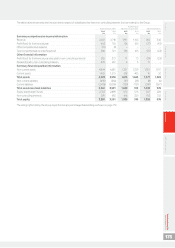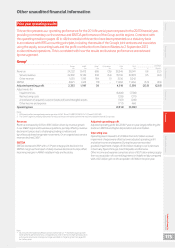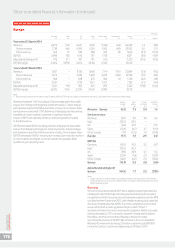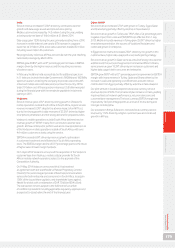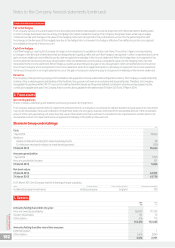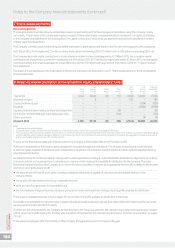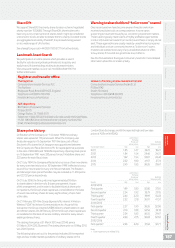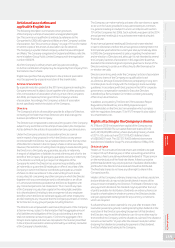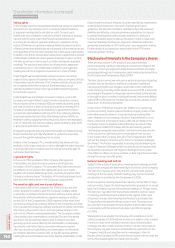Vodafone 2015 Annual Report Download - page 183
Download and view the complete annual report
Please find page 183 of the 2015 Vodafone annual report below. You can navigate through the pages in the report by either clicking on the pages listed below, or by using the keyword search tool below to find specific information within the annual report.
1. Basis of preparation
The separate nancial statements of the Company are drawn up in accordance with the Companies Act 2006 and UK GAAP. The separate nancial
statements are prepared on a going concern basis.
The preparation of Company nancial statements in conformity with generally accepted accounting principles requires management to make
estimates and assumptions that affect the reported amounts of assets and liabilities and disclosure of contingent assets and liabilities at the
date of the Company nancial statements and the reported amounts of revenue and expenses during the reporting period. Actual results could
differ from those estimates. The estimates and underlying assumptions are reviewed on an ongoing basis. Revisions to accounting estimates are
recognised in the period in which the estimate is revised if the revision affects only that period or in the period of the revision and future periods if the
revision affects both current and future periods.
As permitted by section 408(3) of the Companies Act 2006, the prot and loss account of the Company is not presented in this Annual Report.
Theseseparate nancial statements are not intended to give a true and fair view of the prot or loss or cash ows of the Company. The Company
hasnot published its individual cash ow statement as its liquidity, solvency and nancial adaptability are dependent on the Group rather than its
own cash ows.
The Company has taken advantage of the exemption contained in FRS 8 “Related Party Disclosures” and has not reported transactions with fellow
Group undertakings.
The Company has taken advantage of the exemption contained in FRS 29 “Financial Instruments: Disclosures” and has not produced any
disclosuresrequired by that standard, as disclosures that comply with FRS 29 are available in the Vodafone Group Plc consolidated nancial
statements for the yearended 31 March 2015.
Signicant accounting policies applied in the current reporting period that relate to the nancial statements
as a whole
Accounting convention
The Company nancial statements are prepared under the historical cost convention and in accordance with applicable accounting standards
of theUK Accounting Standards Board and pronouncements of the Urgent Issues Task Force.
Foreign currencies
Transactions in foreign currencies are initially recorded at the rates of exchange prevailing on the dates of the transactions. Monetary assets and
liabilities denominated in foreign currencies are retranslated into the Company’s functional currency at the rates prevailing on the balance sheet
date. Non-monetary items carried at fair value that are denominated in foreign currencies are retranslated at the rates prevailing on the initial
transaction dates. Non-monetary items measured in terms of historical cost in a foreign currency are not retranslated.
Exchange differences arising on the settlement of monetary items, and on the retranslation of monetary items, are included in the prot and loss
account for the period. Exchange differences arising on the retranslation of non-monetary items carried at fair value are included in the prot and
loss account for the period.
Borrowing costs
All borrowing costs are recognised in the prot and loss account in the period in which they are incurred.
Taxation
Current tax, including UK corporation tax and foreign tax, is provided at amounts expected to be paid (or recovered) using the tax rates and laws
thathave been enacted or substantively enacted by the balance sheet date.
Deferred tax is provided in full on timing differences that exist at the balance sheet date and that result in an obligation to pay more tax, or a right
to pay less tax in the future. The deferred tax is measured at the rate expected to apply in the periods in which the timing differences are expected
to reverse, based on the tax rates and laws that are enacted or substantively enacted at the balance sheet date. Timing differences arise from the
inclusion of items of income and expenditure in taxation computations in periods different from those in which they are included in the Company
nancial statements. Deferred tax assets are recognised to the extent that it is regarded as more likely than not that they will be recovered.
Deferredtax assets and liabilities are not discounted.
Financial instruments
Financial assets and nancial liabilities, in respect of nancial instruments, are recognised on the Company balance sheet when the Company
becomes a party to the contractual provisions of the instrument.
Financial liabilities and equity instruments
Financial liabilities and equity instruments issued by the Company are classied according to the substance of the contractual arrangements
entered into and the denitions of a nancial liability and an equity instrument. An equity instrument is any contract that evidences a residual
interest in the assets of the Company after deducting all of its liabilities and includes no obligation to deliver cash or other nancial assets.
The accounting policies adopted for specic nancial liabilities and equity instruments are set out below.
Derivative nancial instruments and hedge accounting
The Company’s activities expose it to the nancial risks of changes in foreign exchange rates and interest rates.
The use of nancial derivatives is governed by the Group’s policies approved by the Board of Directors, which provide written principles on the use
of nancial derivatives consistent with the Group’s risk management strategy.
Derivative nancial instruments are initially measured at fair value on the contract date and are subsequently remeasured to fair value at each
reporting date. The Company designates certain derivatives as hedges of the change of fair value of recognised assets and liabilities (“fair value
hedges”). Hedge accounting is discontinued when the hedging instrument expires or is sold, terminated or exercised, no longer qualies for hedge
accounting or the Company chooses to end the hedgingrelationship.
Overview Strategy review Performance Governance Financials Additional information Vodafone Group Plc
Annual Report 2015
181
Notes to the Company nancial statements




